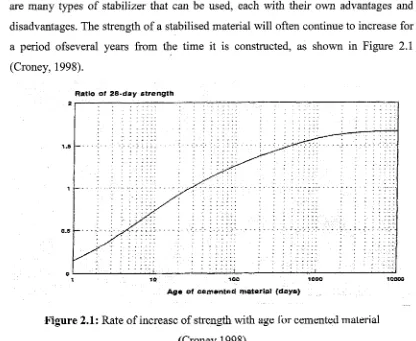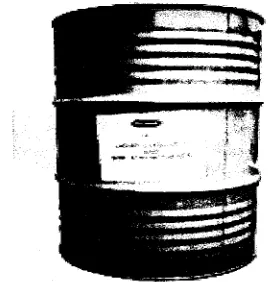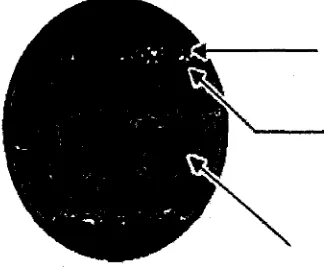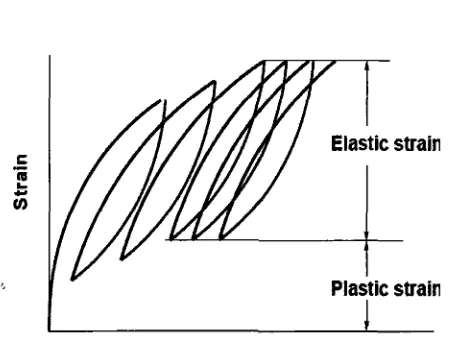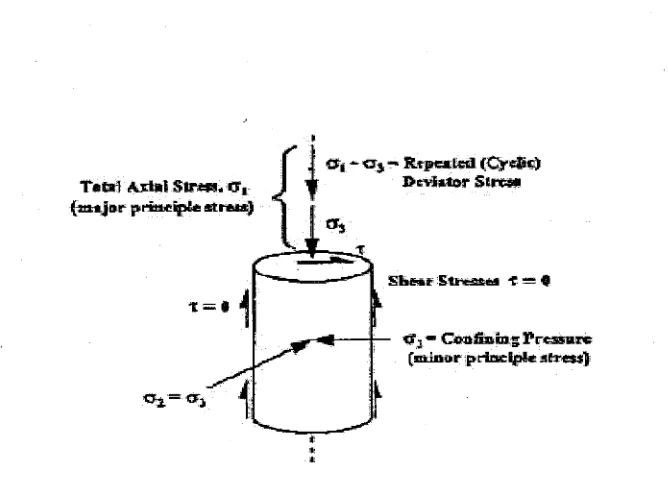EXPERIMENTAL STUDY ON RESILIENT MODULUS OF PROBASE TX-85 STABILIZED SUBGRADE SOIL
MOHAMMAD NASIR BIN MOHAMAD TAHER
SHORT TERM GRANT PHASE 31201 1 NO.VOT 0913
CHAPTER 1
INTRODUCTION
1.1 Background
Unpaved roads are usually used for low volume traffic and serve as access roads. Being basically an agricultural country low volume roads play a very important role in the rural economy and resource industries. When unpaved roads are built on soft foundation soils, large deformations can occur, which increase maintenance cost and lead to interruption of traffic service. The use of soil stabilizer products as an additive in flexible pavements for reinforcement has been demonstrated to be a viable technology through studies conducted over the last three decades which results in increased service life of the pavement or reduced base thickness to carry the same number of load repetitions. Benefits of reducing base course thickness are realized if the cost of the geosynthetic is less than the cost of the reduced base course material. In developing countries like India cost and availability of geosynthetics are the major constraining factors for the construction of reinforced soil structures (Nazarian and Feliberti, 1993).
Hydrated lime and pelletized lime offer alternatives that help reduce the handling issues, but they do not completely eliminate them. Many other non-traditional amendments, including resins and polymers, are marketed, but their performance record is mixed and solid eniineering data is lacking, preventing reliable design (Geiman, 2005). The progressive downward movement of soil into the subgrade and the associated upward squeezing or pumping of subgrade soil into the subgrade base results in intermixing as shown in Figure 1.1.
Figure 1.1: Soil contaminate resulting failure of the road without stabilizer
Characterizing subgrade soils in terms of resilient modulus (MR) is essential for pavement design of both flexible and rigid pavements. MR attribute has been recognized widely for characterizing materials in pavement design and evaluation. Resilient modulus is a measure or estimate of the elastic modulus of the material at a given stress or temperature. Mathematically it is expressed as the ratio of applied deviator stress to recoverable strain (George, 2004).
where, o a = Applied deviator stress
MR is generally estimated directly in the laboratory using repeated load triaxial testing, indirectly through correlation with other standard tests, or by back calculating from deflection tests results. For a new design, MR is generally obtained by conducting repeated load triaxial tests on reconstituted/undisturbed samples.
The 1993 AASHTO Guide for Design of Pavement Structures: Appendix L (3), lists four different approaches to determine a design resilient modulus value. The first approach is laboratory testing, another approach is by Non-Destructive Testing (NDT) backcalculation, the third approach consists of estimating resilient modulus from correlations with other properties, and the last is from original design and construction data. According to George 2004, most of the agencies do not routinely measure the MR in the laboratory, but estimate from experience or from other material or soil properties; i.e., CBR, R-value or physical properties.
Previous research has concentrated on refining the resilient modulus test and reducing its variability, or was directed toward modeling the resilient behavior of pavement materials, especially unbound materials (Nazarian and Feliberti, 1993)
The relative difficulty with which the resilient modulus test is conducted for unbound pavement materials is one of the reasons behind this research. Another reason was the variable nature of these materials whether it is the base, subbase or subgrade materials. By modeling the resilient modulus of unbound pavement materials, equations can be obtained that relate some or all of the resilient parameters to other properties of the material that can easily be tested and quantified (Ping, et a1.,1998).
1.2 Problem Statement
Clays generally exhibit undesirable engineering properties compared with those of granular soils. They tend to have lower shear strength and to lose shear strength further upon wetting or other physical disturbances. They can be plastic and compressible and they expand when wetted and shrink when dried. The problem such as high compressibility and low shear strength usually occur and it is common in the construction of embankments. In construction of unpaved roads, the stress is always acting in the direction of vertical and horizontal, and effective stress is depend on stability condition during and after construction. Common behavior of foundation soil under the unpaved road is like settlement, lateral movement, pore water pressure and total stress. All of these behaviors are related to each other.
The purpose of this study is to determine the resilient of Probase TX-85 stabilized subgrade soil. Hence, the following objectives were persued in this study :
1. To investigate the engineering properties of subgrade soil used in this study
2. To determine the optimum TX-85 content as a soil stabilizer based on unconfined compressive strength.
3. To analyze and compare the subgrade soil strength and Resilient Modulus of unpaved roads with and without stabilizer
1.4 Scope and Limitation
The primary purpose of this research focused on the TX-85 effect of the subgrade soil that have caused problems during construction or resulted in poor performance in service. The selected stabilizers are Probase TX-85 (powder), Probase TX-85 (liquid) and Probase TX-85 combination (powder and liquid).The scope of this research includes:
Characterizing the soils by performing the following tests: specific gravity, particle size distribution, Atterberg limits and moisture-density relationship using standard and modified Proctor effort.
Developing a laboratory mixture preparation and testing procedure that can be used to evaluate and compare subgrade soil with and without stabilizers.
Identifying the existence and significance of trends among base soil characteristics, amendment type, amendment dose rate, and strength characteristics using the laboratory procedure developed.
Specimens prepared near the optimum water content give an indication of how well the amendments can strengthen and stiffen a subgrade in order to help reduce the required thickness of the pavement section. Specimens prepared substantially above the optimum water content give an indication of whether the workability of the soil can be improved such that the soils can be compacted to an adequate strength and stiffness without extensive drying andlor processing.
1.5 Significants of study
This research provides insight into which stabilizers are most effective for stabilizing subgrade soils commonly encountered in Parit Raja. This report is not meant to replace laboratory testing on specific projects; however, it can be used as a guide to help select an appropriate stabilizer type and amount based on soil properties and desired strength. In addition, the laboratory procedure developed for this research can be used to help evaluate specific soils for specific projects.
T h s study was undertaken to provide an understanding of the options for soil supply in road construction particular subgrade layer. This research fulfils the need of the person who involves on road design and construction. It also hopes to give an alternative idea to highway engineer and contractors in respect of stabilization on road subgrade. This research will provide the alternative material in unpaved road structure which will then eventually increase bearing capacity and also decrease the plasticity index.
CHAPTER 2
LITERATURE RIVEW
2.1 Introduction
The objectives of this literature review are to identity the research of previously published on the unpaved road system on soft subgrade, type of soil stabilization and behavior of soft soil. The primary focuses are on determination of the resilient modulus from soil index properties and followed by review of previous research on similar work.
2.2 SoftSoil
2.2.1 Soil Classification
i. Gravel -particles from 60 mm to 2 mm ii. Sand - particles from 2 rnm to 0.06 mm iii. Silt - particles from 0.06 mm to 0.002 mm
iv. Clay - particles (clay mineral) smaller than 0.002 mm v. Fines are particles which pass a 63 pm sieve
vi.Clay Fraction is the percentage of particles smaller than 2pm, as determined by a standard sedimentation procedure
2.2.2 Characteristic of Clay Soil
Particles forming clay consist of complex minerals which are mostly flat and plate- like or elongated, and of a size less than 0.002 mm. The most significant properties of clays are its plasticity and cohesion. Clay soils able to take and retain a new shape when compressed or moulded (Whitlow, 1995). The size and nature of the clay mineral particles, together with the nature of the adsorbed layer, controls this property. Where the average specific surface is high, this plasticity may be extremely high and the soil extremely compressible.
Cohesive soils generally exhibit undesirable engineering properties compared with those of granular soils. They tend to have lower shear strength further upon wetting or other physical disturbances. They can be plastic and compressible and they expand when wetted and shrink when dried. Clay soils can creep (deform plastically) over time under constant load, especially when the shear stress is approaching it shear strength, making them prone to landslides.
2.2.3 Problem of Clay Soil
Saturated cohesive soil can be susceptible to a large amount of settlement from structural loads. It is usually the direct weight of the structure that causes settlement of the cohesive soil. However, secondary influences such as the lowering of the groundwater table can also lead to settlement of cohesive soils. The soil parameters normally employed and characterized in soft soil problems are:
i. Classification and Index Properties, and Natural Moisture Content ii.Undrained Shear Strength (S,)
iii. Pre-Consolidation Pressure (PC)
Iv.Compression Index (C,) and the Coefficient of Volume Change (m,) v. Coefficient of Consolidation (c,)
The parameters are very important in analyzing the behavior of this soil so that it can carry extra loads subjected to the soils. These nature creatures are widely found in Malaysia along the coastal plains area and with the increasing economic development over the soil; studies were carried out to determine the typical values of the soils that can contribute to the failure of the soil structure.
2.3 Stabilized Subgrade Road System
2.3.1 Introduction
In addition, it may provide a greater resistance to the ingress of water. There are many types of stabilizer that can be used, each with their own advantages and disadvantages. The strength of a stabilised material will often continue to increase for a period ofseveral years from the time it is constructed, as shown in Figure 2.1 (Crone y,
Age of cemented matortal {deya)
Figure 2.1: Rate of increase of strength with age for cemented material (Croney, 1998)
The type and quantity of stabilizer added depends mainly on the strength and performance that needs to be achieved. The addition of even small amounts of stabilizer, for example up to 2 per cent cement, can modify the properties of a material. Larger amounts of stabilizer will cause a large change in the properties of that material, for example 5 to 10 per cent of cement added to clean gravel will cause it to behave more like a concrete. The strength of a stabilized material will depend on many factors. These include:
the chemical composition of the material to be stabilised; the stabiliser content;
the degree of compaction achieved; the moisture content;
[image:12.526.55.471.74.415.2]When small quantities of stabiliser are added, the material is often described as 'modified' rather than 'bound7. There are no fixed criteria for these definitions, but a limit of 80kPa (indirect tension) or 800kPa (Unconfmed Compressive Strength after 7days moist curing) for a reasokably graded material is suggested by NAASRA (1986).
2.4 Types of Stabilisation
[image:13.526.86.451.543.708.2]Stabilization is the process of mixing a stabilizer, for example cement, with a soil or imported aggregate to produce a material whose strength is greater than that of the original unbound material. The use of stabilization to improve the properties of a material is becoming more widespread due to the increased strength and load spreading ability that these materials can offer. Stabilization technology is extremely relevant for heavily trafficked pavements where its benefits are beginning to be appreciated (Little, 1995). This study describes the basic types of stabilization, indicates when it should be used, and discusses the main advantages and disadvantages of its use
Figure 2.2 shows normal soil densities are loose with air void content that easily allows water penetration. Soil particle with high Plastic Index (PI) will absorbe water. Water act as lubricant cause the soil road to be slippery. When vehicle passing through, soil particle easily move around with the present of water, eventually created pot hole and depression damage especially during rainy season.
Normal Soil Soil treatment Process
2.4.1 Mechanical Stabilisation
The most basic form of mechanical stabilisation is compaction, which increases the performance of a natural material. Mechanical stabilisation of a material is usually achieved by adding a different material in order to improve the grading or decrease the plasticity of the original material. The physical properties of the original material will be changed, but no chemical reaction is involved. For example, a material rich in fines could be added to a material deficient in fines in order to produce a material nearer to an ideal particle size distribution curve (Metcalf, 1977).
This will allow the level of density achieved by compaction to be increased and hence improve the stability of the material under traffic. The proportion of material added is usually from 10 to 50 per cent. Providing suitable materials are found in the vicinity, mechanical stabilisation is usually the most cost-effective process for improving poorly-graded materials. This process is usually used to increase the strength of a poorly-graded granular material up to that of a well-graded granular material. The stifhess and strength will generally be lower than that achieved by chemical stabilisation and would often be insufficient for heavily trafficked pavements (Metcalf, 1977). It may also be necessary to add a stabilising agent to improve the final properties of the mixed material.
2.4.2 Cement Stabilisation
materials, i.e. greater than about 10 MPa cube strength at 7 days, the materials should generally be plant mixed (Detr, 1998).
One of the main problems with stabilising a material is mixing in the cement. The particle size of ordinary Poiland cement is quite well defined with a range of 0.5-100 microns and a mean of 20 microns (Ingles & Metcalf, 1972). The larger particles of cement never completely hydrate, and it has been found that the same amount of a more finely ground cement will produce higher strengths. Finely ground cements are, however, expensive to produce and it has been suggested (Ingles & Metcalf, 1972) that the larger particles of cement could be replaced with smaller particles of inert filler.The greater bulk would aid the distribution process so that the same amount of active cement would be available throughout the material. Thus producing an equally effective binder, this could be cheaper than ordinary cement.
The use of cement as a stabiliser is more widespread than lime. This is due to many reasons, but the main factors are likely to be the cost and the higher strengths that are attainable using cement. Other factors include availability, past experience and the more hazardous nature of lime. The price of cement is often similar to that of quicklime or hydrated lime, however cement can be used on a wider range of materials and the strengthening effect of cement is much more than that of an equal amount of lime. Hence either higher strengths are possible using an equal amount of cement instead of lime or the same specified strength can be achieved using a lower quantity of cement than lime (Shewood, 1993).
2.4.3 Lime Stabilisation
The stabilisation of subgrade materials is not new; with examples of lime stabilisation being recorded in the construction of early Roman roads. However, the invention of Portland cement in the 19tll Century resulted in cement replacing lime as the main type of stabiliser.
from chalk or limestone by heating and combining with water. The term 'lime' is broad and covers the following three main types:
i) quicklime -calcium oxide (CaO),
ii) slaked or hydrated lime - calcium hydroxide (Ca(OH)2) and iii) carbonate of lime - calcium carbonate (CaC03).
Only quicklime and hydrated lime are used as stabilisers in road construction. They are usually added in solid form but can also be mixed with water and applied as a slurry. It must be noted that there is a violent reaction between quicklime and water and consequently operatives exposed to quicklime can experience severe external and internal burns, as well as blinding.
Hydrated lime is used extensively for the stabilisation of soil, especially soil with a high clay content where its main advantage is in raising the plastic limit of the clayey soil. Very rapid stabilisation of water-logged sites has been achieved with the use of quicklime. Small quantities (typically 1-3 %) are used to reduce the plasticity of the clay. It is reported that such small quantities usually result in a small increase in CBR strength although no significant increase in compressive or tensile strength should be expected (Paige-Green,l998). Paige-Green reports that typically, a minimum of 3 to 5 per cent stabiliser is necessary to gain a significant increase in the compressive and tensile strength.
2.4.4 Asphalts
in water). When the solvent evaporates or the emulsion 'breaks', the bitumen is deposited on the material.
According to O'Flaherty, 1985, the bitumen merely acts as a glue to stick the material particles together and prevent the ingress of water. In many cases, the bituminous material acts as an impervious layer in the pavement, preventing the rise of capillary m0isture.h a country where bitumen is relatively expensive compared to cement and where most expertise is in cement construction, it appears more reasonable to use a cement stabiliser rather than a bitumenltar based product
.
2.4.5 Soybean Oil
This product is known technically as Acidulated Soybean Oil Soap stock. It is a by- product of the caustic refining process of soybean oil. It is a biodegradable material that has many of the characteristics of light petroleum based oil. It will penetrate a gravel surface and provide a light bonding of the gravel that effectively reduces dust when it is used properly (Paige-Green, 1998).
2.5 TX-85 Double Strength Liquid Soil Stabilizer
In this study, TX-85 double strength liquid and powder soil stabilizer have been used. It is 100% organic and derived from combined organic sulphur and buffered acids that are combined as bi-sulphates.It also water-soluble soil stabilizer chemical used in construction of unpaved roads.
Figure 2.3 shows that TX-85 is non toxic and poses no threat to groundwater supplies or flora and fauna. It also reduces the plastic index of the soil and improves its CBR ratings. These stabilizer is an economical construction methods especially
for rural and estate roads and does not consume in its function but continues and
Figure 2.3: Probase TX85 Soil Stabilizer
TX-33 Liquid Sealer and Dust Control
TX-33 provides extra strength and protection on the treated road. This surface can also act as wearing surface for the road. It also prevents water penetration, erosion and provided a dust free road. Figure 2.4 shows the cross section for TX-85 treated soil consist a layer of quarry dust, TX-33 protective layer and TX-85 treated soil base.
2.7 Benefits of Stabilization
A road surface that remains tightly bound and stable will require much less blade maintenance. The manufacturers of some dust control products highly recommend that the surface should not be bladed at all after their products are applied. While extra blading, sha<ing and mixing is needed to prepare a road for dust control, the overall need for blade maintenance should be greatly reduced.
A layer of Quarry dust or Chip stone to avoid slippers on the road surface
TX-33 protective layer to prevent water penetration, erosion and provided a dust fiee road
[image:19.528.79.241.200.335.2]TX-85 Treated soil base (150mm- 200mm thick)
Figure 2.4: Cross section for TX-85 treated soil
2.8 Resilient Modulus
(MR)
Since the pavement materials are subjected to a series of distinct load pulses, a
laboratory test duplicating this condition is desirable. The repeated load type test has been used for many years to simulate vehicle loading. In this test, cylindrical specimens of soil are subjected to a series of load pulses applied with a distinct rest period, simulating the stresses caused by multiple wheels moving over the pavement. A constant all-around confining pressure applied on the specimen simulates the lateral stresses caused by the overburden pressure and applied wheel load. The total resilient (recoverable) axial deformation response of the specimen to the stress pulses measured is used to calculate the resilient modulus of the material. Cited below are two reasons favoring the use of repeated load triaxial test for determination of MR .
evidence show that MR is stress dependent. Thus, the use of a "non-linear elastic" hypothesis could be more accurate to describe the variation of the MR with the applied stress state. Some model have been developed describing this type of behavior to be used in computational pavement design method and they are based on MR result obtain in the laboratory fiom the repeated triaxial test (Angelone and Martinez, 2000).
Axial, radial, and volumetric strains can all be measured in the triaxial test. For about the last 35 years the repeated load triaxial compression test has been the basic test procedure to evaluate resilient modulus of cohesive and granular materials for pavement design applications.
Figure 2.5 shows the straining of a specimen under a repeated load test. At the initial stage of load applications, there are considerable permanent deformations, as indicated by the plastic strain in the figure. As the number of repetition increase, the plastic strain due to each load repetition decreases. After 100 to 200 repetition, the strain is practically all recoverable as indicated by Or in the figure (Huang.Y.H,2004).
[image:20.528.161.389.521.697.2]The procedure for determining the resilient modulus of aggregate materials is specified by AASHTO Designation TP 46-94. Meanwhile, Figure 2.6 shows the applying stresses to a triaxial specimen and relationship between resilient modulus and bulk stress for stabilized fine grained material as shown in Figure 2.7.
Figure 2.6: Stresses Applied to a Triaxial Specimen (Mathew, 2003)
-63
IL
E Q
z5
6
9
-
= 6fi
-
6
L l
Bulk stretrslaa
[image:21.526.104.440.350.642.2]CB-v, + Z e E I 1
2.9 Resilient Modulus Models
The resilient modulus MR is a dynamic test response defined as the ratio of the repeated axial deviator stress d to the recoverable axial strain a.
It is known that the resilient modulus is a stress dependent parameter. Research has been directed toward developing a reliable MR testing system, modeling MR as a function of stresses andlor strains and development of relationships between MR or MR model constants and soil properties. Several models relating MR to stress state have been suggested (Pezo, 1993; Thompson, 1989; Mohammad et al., 1994; and Moassazadeh and Witczak, 1981) for cohesive and cohesionless materials. A relationship that has gained wide acceptance for fine-grained soil is of the form (Moassazadeh and Witczak, 198 1):
Where: MR = resilient modulus
C T ~ = sum of the principal stresses Ki and K2 = experimental coefficient.
and
MR
= K2+
K4 (od -K1) for K1 < od (2.3)Where: K.2 = the value of MR at the point od = K l and K3
K4 = slopes of the portions of the curve representing MR. o d = relationship when MR is less than and more than K1 sum
of the principal stresses
Where: O = G ~ + ( 5 2 + ~ 3 = ~ ~ + 2 ( 5 ~ = ( 5 ~ + 3 ( 5 ~
Historically, due to difficulties associated with resilient modulus testing, various approximate empirical formulae have been suggested to estimate MR from CBR by many researchers (Powell et al., 1984; Witczak et al., 1995). However, these types of models have not been universally accepted as on one hand, they were developed for certain localities and cannot be generalized, and on the other hand they do not recognize the stress dependence of MR (Rada and Witczak, 198 1; Drumm et al., 1990).
Pezo (1993) proposed a stress dependent model that incorporates both deviatoric and confining stresses. The model can be used for both cohesive and cohesionless soils. The soil type is reflected by the weight given to either deviator or confining stresses in the model which is developed by regression analysis. The model is of the following form:
Where : K1, K2 and K3 are regression constants.
C T ~ = Standard deviator stress
(53= Confining Stress
2.10 Factors Affecting Resilient Modulus Test
The resilient modulus of fine-grain soils is not a constant stiffness property but depends upon various factors like load state or stress state, which includes the deviator and confining stress, soil type and its structure, which primarily depends on compaction method and compaction effort of a new subgrade. Previous studies show that deviator stress is more significant than confining stress for fine-grain soils. Resilient modulus is found to increase with a decrease in moisture content and an increase in density, and decrease with an increase in deviator stress.
For coarse-grain soils, MR is primarily influenced by the stress state, degree of saturation and compactive effort (density). Lekarp, 2000 found that MR increases with increasing confining stress. Studies have also indicated that there is a critical degree of saturation near 80-85 percent, above which granular material becomes unstable and undergoes degradation rapidly under repeated loading. Lekarp et al. noted, and other researchers concur that MR of granular materials increases with increasing confining stress and sum of principal stresses, otherwise known as bulk stress ( O ) , and slightly increases with deviator stress.
For the road pavement design, it is important to consider how the resilient behavior varies with changes in different influencing factor. The resilient behavior of unbound granular material is affected by several factors such as
1. effect of stress
. .
11. effect of density
. . .
in. effect of grading
iv. effect of moisture content
REFERENCES
AASHTO Guide for Design of Pavement structures, (1986), American Association of State Highway and Transportation Officials, Washington, DC.
AASHTO Guide for Design of Flexible pavement Structures,(l993) American Association of State Highway and Transportation Officials, Appendix L Washington, DC.
Al-Suhaibani, A., Al-Refeai, T. and Noureldin, A. (1997) "Characterization of Subgrade Soil in Saudi Arabia; A study of Resilient Behavior," KACST
Project No. AR-12-51, Final report.
Angelone M and Martinez, (2000) "Regression Model for Resilient Modulus of Subgrade Soils", Transportation Research Record 1442, TRB, National Research Council, Washington, D .C., pp 47-54.
Austroads Pavement Research Group, (1993). " Characterisation of Unbound Pavementand Sub Grade Using Repeated Loading Triaxial Testing." Australian Road Research Board Ltd. APRG report No.8.
Barksdale, R.D., Jorge, A., Khosla, N.P., Kim, K., Lambe, P.C., Rahman, M.S., (1998), "Laboratory Determination of Resilient Modulus for Flexible Pavement Design: Final Report
",
NCHRP project 1-28.Detr. Series 1000: (1998) Road Pavements - Concrete and Cement BoundMaterials. Manual of Contract Documents for Highway Works (MCHW) Volume 1: Specification for Highway Works, UK Dept of the Environment, Transport and the Regions.
Drurnm, E., Boateng-Poku, Y. and Johnson Pierce, T, (1990) "Estimation of Subgrade Resilient Modulus from Standard Tests," Journal of Geotechnical Engineering, ASCE, 1 16(5):774-789.
Fredrick Lekarp and Andrew Dawson. (2000). "Resilient Response of Unbound Aggregates." Journal of Transportation Engineering JanuarylFebruary pages (66 - 75)
Geiman ( 2005). " Stabilization of soft clay subgrades in Virginia Phase 1 laboratory
study." Blacksburg, Virginia
Head, K.H. (1992). "Manual of Soil Laboratory Testing". Volume I : Soil
Classzfication and Compaction Test. 2th.ed. London: Pentech Press Limited
Graham Lodge
Head, K.H. (1988). "Manual of Soil Laboratory". Volume 2: Permeability, Shear Strength and Compressibility Test. London: Pentech Press Limited Graham
Lodge.
Head, K.H. (1986). "Manual of Soil Laboratory". Volume 3: Eflective Stress Tests. London: Pentech Press Limited Graham Lodge.
Holtz, R.D. and Kovacs, W.D. (1981). "An Introduction to Geotechnical Engineering

